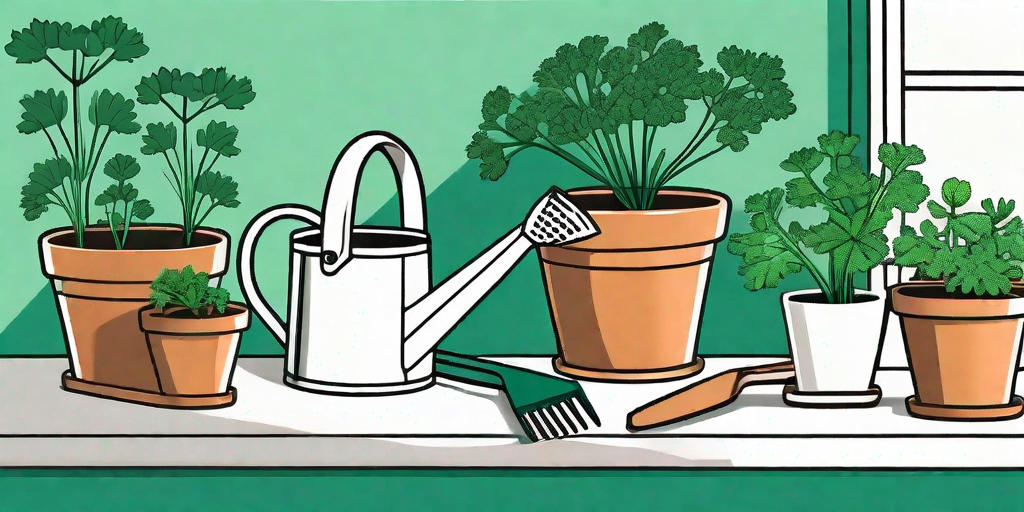
Welcome, budding horticulturists and parsley enthusiasts! If you've ever wondered how to transform your indoor space into a lush, green herb garden, you're in the right place. Today, we're focusing on the humble parsley, a versatile herb that's not only a culinary delight but also a sight for sore eyes. Let's dive into the world of indoor parsley cultivation, shall we?
Understanding Parsley: More Than Just a Garnish
Before we delve into the nitty-gritty of parsley cultivation, let's take a moment to appreciate this underrated herb. Often relegated to the role of a garnish, parsley is a culinary powerhouse packed with flavor and nutritional benefits.
There are two main types of parsley: curly leaf and flat leaf. While both are equally delightful, they do have subtle differences in taste and appearance. Curly leaf parsley is often used as a garnish due to its vibrant green color and intricate leaf pattern. Flat leaf parsley, on the other hand, has a slightly stronger flavor and is a favorite in Mediterranean cuisine.
The Nutritional Benefits of Parsley
Did you know that parsley is a nutritional superstar? This humble herb is rich in vitamins A, C, and K, and also contains folate and iron. It's a great way to add a nutritional boost to your meals without adding extra calories.
Plus, parsley has been known to have anti-inflammatory properties and can aid in digestion. So, the next time you see parsley on your plate, don't just push it aside. It's doing a lot more than just making your meal look pretty!
Getting Started: Choosing Your Parsley
Now that we've sung the praises of parsley, let's get down to business. The first step in growing parsley indoors is choosing the right type for your needs. As mentioned earlier, there are two main types: curly leaf and flat leaf. Both can be grown indoors, so it's really a matter of personal preference.
When choosing your parsley, look for plants that are vibrant green and free from any signs of disease or pests. A healthy plant will give you the best chance of success.
Seeds or Seedlings?
Another decision you'll need to make is whether to start with seeds or seedlings. Starting from seeds can be a rewarding experience, but it does require a bit more patience. Parsley seeds can take up to three weeks to germinate, so if you're looking for instant gratification, you might want to opt for seedlings.
On the other hand, starting from seedlings can give you a head start on the growing process. Just make sure to choose seedlings that are healthy and robust.
Planting Your Parsley
Once you've chosen your parsley, it's time to get planting. But before you start, you'll need a few supplies:
- A pot with drainage holes
- Potting soil
- A sunny spot
Parsley prefers well-draining soil, so make sure your pot has drainage holes to prevent waterlogging. As for the soil, a good quality potting mix should do the trick. And finally, choose a sunny spot for your parsley. This herb loves the sun and needs at least six hours of sunlight each day.
When planting your parsley, make sure to bury the seeds or roots just below the surface of the soil. Water thoroughly and then sit back and wait for the magic to happen!
Looking After Your Parsley
Now that your parsley is planted, it's time to switch into caretaker mode. Parsley isn't a high-maintenance plant, but it does require a bit of TLC to thrive.
Firstly, make sure your parsley gets plenty of sunlight. If you notice the leaves turning yellow, it might be a sign that your plant isn't getting enough light. In this case, consider moving your plant to a sunnier spot or supplementing with a grow light.
Secondly, keep an eye on the soil moisture. Parsley likes evenly moist soil, but not waterlogged. A good rule of thumb is to water when the top inch of soil feels dry to the touch.
Pest Control
Like any plant, parsley can be susceptible to pests. Common culprits include aphids and whiteflies. If you notice any unwanted visitors on your parsley, don't panic. There are plenty of natural pest control methods you can try, such as introducing beneficial insects or using a homemade insecticidal soap.
Remember, a healthy plant is the best defense against pests. So, keep your parsley happy and healthy, and it will reward you with lush, green growth.
Harvesting Your Parsley
After all your hard work, it's time to reap the rewards. Parsley can be harvested as soon as the plant has multiple stems. To harvest, simply cut off the stems at the base of the plant. This will encourage more growth and ensure you have a steady supply of fresh parsley.
Remember, parsley is a cut-and-come-again plant, meaning the more you harvest, the more it grows. So, don't be shy about using your homegrown parsley in your favorite recipes.
Frequently Asked Questions
How long does it take for parsley to grow?
Parsley seeds can take up to three weeks to germinate, and the plant reaches maturity in about 70 to 90 days. However, you can start harvesting as soon as the plant has multiple stems.
Can I grow parsley from a supermarket plant?
Absolutely! Just make sure the plant is healthy and free from any signs of disease or pests. Transplant it into a pot with well-draining soil and place it in a sunny spot.
Why is my parsley turning yellow?
Yellowing leaves can be a sign of several issues, including overwatering, underwatering, or lack of sunlight. Check the soil moisture and light levels and adjust as necessary.
Conclusion
And there you have it, folks! Everything you need to know to successfully grow parsley indoors. With a bit of patience and care, you'll soon have a lush, green parsley plant to brighten up your indoor space and spice up your meals. So, what are you waiting for? It's time to get your green thumbs sprouting!











